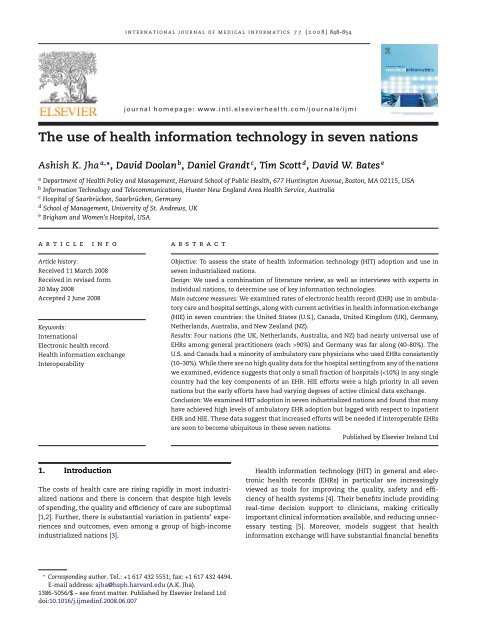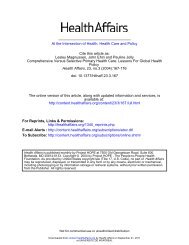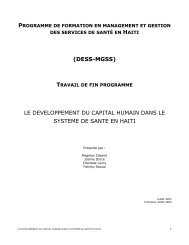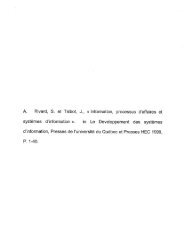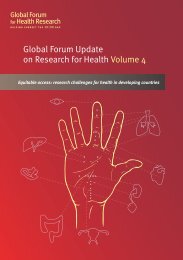The use of health information technology in seven nations
The use of health information technology in seven nations
The use of health information technology in seven nations
- No tags were found...
Create successful ePaper yourself
Turn your PDF publications into a flip-book with our unique Google optimized e-Paper software.
<strong>in</strong>ternational journal <strong>of</strong> medical <strong>in</strong>formatics 77 (2008) 848–854 851Adoption <strong>of</strong> electronic <strong>health</strong> records <strong>in</strong> Canadian hospitalsis also <strong>in</strong> its <strong>in</strong>fancy. Very few Canadian hospitals <strong>use</strong>electronic prescrib<strong>in</strong>g, <strong>in</strong> part beca<strong>use</strong> they rely on local operat<strong>in</strong>gor capital budgets rather than on national fund<strong>in</strong>g tosupport these programs. Similarly, Australia and New Zealandhave computerized patient adm<strong>in</strong>istration systems and many<strong>use</strong> laboratory results report<strong>in</strong>g. However, computerized documentationis limited to electronic discharge summaries whichare sent directly from hospitals to general practitioners andthere is little to no electronic prescrib<strong>in</strong>g <strong>in</strong> the hospital sett<strong>in</strong>g.3.3. Health <strong><strong>in</strong>formation</strong> exchangeDespite widespread <strong>in</strong>terest, cl<strong>in</strong>ical data exchanged acrossproviders rema<strong>in</strong>s low <strong>in</strong> each country. In some countries, HIEhas begun <strong>in</strong> earnest with substantial resources dedicated t<strong>of</strong>urther expansion, though other <strong>nations</strong> are still <strong>in</strong> the plann<strong>in</strong>gstages.In the U.S., much <strong>of</strong> the focus on shar<strong>in</strong>g <strong>of</strong> data betweenproviders has been organized around Regional Health InformationOrganizations (RHIOs). <strong>The</strong>se entities have alreadybeen started <strong>in</strong> many regions [23]. RHIOs are generally nonpr<strong>of</strong>itregional organizations whose primary aims are toconvene provider organizations with the hope <strong>of</strong> <strong>in</strong>itiat<strong>in</strong>g<strong>health</strong> data exchange. Prelim<strong>in</strong>ary reports suggest that onlya small number (fewer than a dozen) have begun to exchangecl<strong>in</strong>ical data [24]. Furthermore, the f<strong>in</strong>ancial susta<strong>in</strong>ability <strong>of</strong>RHIOs, a critical factor <strong>in</strong> their long-term success, rema<strong>in</strong>sunknown.<strong>The</strong> Canadian approach has foc<strong>use</strong>d on Infoway, a nationaleffort to provide vision and strategy to <strong>in</strong>crease the nationaladoption <strong>of</strong> EHRs. On the HIE front, Infoway promotes the<strong>in</strong>terchange <strong>of</strong> a wide array <strong>of</strong> cl<strong>in</strong>ical data, <strong>in</strong>clud<strong>in</strong>g laboratory,pharmacy, and hospital <strong><strong>in</strong>formation</strong>. One <strong>of</strong> Infoway’sprimary goals is to implement an <strong>in</strong>teroperable EHR for50% <strong>of</strong> Canadians by 2010. Beca<strong>use</strong> Infoway envisages aneventual pan-Canadian <strong>in</strong>teroperable EHR, it is currentlydevelop<strong>in</strong>g privacy and security standards [24]. Prov<strong>in</strong>cessuch as Alberta and Newfoundland are <strong>in</strong> the process <strong>of</strong>implement<strong>in</strong>g prov<strong>in</strong>ce-wide programs to allow data shar<strong>in</strong>gacross hospitals, cl<strong>in</strong>ical laboratories, and physicians’ <strong>of</strong>fices[25]. However, poor underly<strong>in</strong>g levels <strong>of</strong> EHR <strong>use</strong> <strong>in</strong> the primarycare and hospital sett<strong>in</strong>gs have h<strong>in</strong>dered widespreadHIE.HIE has received substantial attention from national policymakers <strong>in</strong> Europe. <strong>The</strong> National Programme for IT (NPfIT) <strong>in</strong>the UK has prioritized shar<strong>in</strong>g <strong>of</strong> cl<strong>in</strong>ical data across providersand the automatic transmission <strong>of</strong> electronic prescriptions topharmacies. To this end, the National Health Service has allocated£12.4 billion to NPfIT to build an <strong>in</strong>tegrated national EHRsystem, which will also be <strong>use</strong>d by pharmacies and laboratories.Approximately 5% <strong>of</strong> prescriptions are be<strong>in</strong>g transmittedelectronically to pharmacies. A current pilot project is thePrimary Care Summary Record program, which pulls keypieces <strong>of</strong> data from the EHR and transmits a summary tothe National Sp<strong>in</strong>e for authorized pr<strong>of</strong>essionals to access.As <strong>of</strong> fall 2007, approximately 14% <strong>of</strong> primary care practiceswere able to create and transmit this summary record. Furthermore,the GP2GP program, whose goal is to ensure thetransmission <strong>of</strong> the full EHR between GPs, is <strong>in</strong> early stages <strong>of</strong>test<strong>in</strong>g.While there is currently no provider-to-provider exchange<strong>of</strong> cl<strong>in</strong>ical <strong><strong>in</strong>formation</strong> <strong>in</strong> the Netherlands, it is a central goal<strong>of</strong> the Dutch government to obta<strong>in</strong> such <strong>in</strong>teroperability. <strong>The</strong>primary focus is the SwitchPo<strong>in</strong>t, a program <strong>in</strong>tended to helpproviders communicate medication lists and cl<strong>in</strong>ical summariesto other providers. <strong>The</strong> SwitchPo<strong>in</strong>t project is still <strong>in</strong>a nascent stage, with f<strong>in</strong>al tests hav<strong>in</strong>g recently been completed.<strong>The</strong> pilot phase, which began <strong>in</strong> late fall 2006, will berolled out to regions that cover 1–2 million patients.We found no s<strong>in</strong>gle approach to HIE <strong>in</strong> Germany. Whilemajor <strong>health</strong>care s<strong>of</strong>tware companies have attempted to createan <strong>in</strong>frastructure for physicians to exchange cl<strong>in</strong>ical data,these efforts have had m<strong>in</strong>imal success. Due to security concerns,many physicians prefer to store patient records oncomputers that are not connected to the Internet. Despitethis obstacle to HIE adoption, there are currently two pilotprojects foc<strong>use</strong>d on provid<strong>in</strong>g <strong>health</strong> <strong><strong>in</strong>formation</strong> exchangecapabilities for providers. <strong>The</strong> first, called “D2D” (www.d2d.de)is a secure communication standard to exchange bill<strong>in</strong>g<strong><strong>in</strong>formation</strong> and patient data. About 2300 (less than 2%) <strong>of</strong>German physicians <strong>in</strong> private practice are participat<strong>in</strong>g <strong>in</strong>the D2D pilot program, which conducts approximately 70,000data transactions per month. <strong>The</strong> second program, “VitaX,” <strong>of</strong>fers EHRs and supports provider-to-provider exchange.While Vita X is also <strong>in</strong> its <strong>in</strong>fancy, its <strong>use</strong> is expected tobecome more widespread, as it is provided by the same vendorthat supplies EHR systems to 50% <strong>of</strong> the German privatepractices.<strong>The</strong> most promis<strong>in</strong>g approach to HIE <strong>in</strong> Germany is theelectronic <strong>health</strong> <strong>in</strong>surance card. Although the card currentlyholds adm<strong>in</strong>istrative data only, the next generation <strong>of</strong><strong>technology</strong> will allow access to electronically stored patientmedical <strong><strong>in</strong>formation</strong>. It will <strong>in</strong>itially <strong>in</strong>clude only emergencydata set and medication history but all key elements <strong>of</strong> apatient’s EHR should be available. <strong>The</strong> voluntary programwill also support electronic transmission <strong>of</strong> prescriptions to apharmacy.<strong>The</strong>re has been some implementation <strong>of</strong> HIE <strong>in</strong> bothAustralia and New Zealand with more likely to come.In Australia, the National E-Health Transition Authority(www.nehta.gov.au) has undertaken substantial plann<strong>in</strong>g forHIE implementation. In addition, a New South Wales pilotproject is encourag<strong>in</strong>g hospitals and community providers toexchange cl<strong>in</strong>ical data for some 50,000 patients. Current HIE <strong>in</strong>both Australia and New Zealand allows GPs with EHRs to automaticallydownload pathology reports and imag<strong>in</strong>g reportsfrom a variety <strong>of</strong> public and private diagnostic sectors. Inaddition, both countries also have national immunization registries(and Australia has a cervical smear registry, as well),which can be fed and accessed electronically. F<strong>in</strong>ally, <strong>in</strong> both<strong>nations</strong>, hospitals are <strong>in</strong>creas<strong>in</strong>gly send<strong>in</strong>g discharge summarieselectronically to GPs, who <strong>in</strong> turn are send<strong>in</strong>g referralsand other communications to hospitals and specialists electronically.Some experts suggest that the lack <strong>of</strong> a s<strong>in</strong>glenational identifier code has h<strong>in</strong>dered HIE <strong>in</strong> Australia to a substantialdegree. New Zealand, by contrast, which does have as<strong>in</strong>gle consumer <strong>health</strong> identifier, may have an easier timecreat<strong>in</strong>g a national HIE program.
852 <strong>in</strong>ternational journal <strong>of</strong> medical <strong>in</strong>formatics 77 (2008) 848–8544. DiscussionWe exam<strong>in</strong>ed the state <strong>of</strong> electronic <strong>health</strong> record adoptionand <strong>health</strong> <strong><strong>in</strong>formation</strong> exchange <strong>in</strong> <strong>seven</strong> <strong>in</strong>dustrialized<strong>nations</strong> and found both similarities and strik<strong>in</strong>g differencesamong them. While the adoption and <strong>use</strong> <strong>of</strong> EHR systems <strong>in</strong>the hospital sett<strong>in</strong>g was <strong>in</strong> its early stages <strong>in</strong> every nation,most <strong>nations</strong> were far ahead <strong>of</strong> the United States <strong>in</strong> adoption<strong>of</strong> EHR <strong>in</strong> the ambulatory care sett<strong>in</strong>g. While fewer than 1 <strong>in</strong> 4ambulatory care physicians <strong>in</strong> the U.S. <strong>use</strong> an EHR and fewerthan 1 <strong>in</strong> 10 such physicians prescribe electronically, nearlyall general practitioners <strong>in</strong> the UK, Netherlands, Australia andNew Zealand do both. Germany lags beh<strong>in</strong>d these four <strong>nations</strong>,though it is ahead <strong>of</strong> the U.S., while Canada’s ambulatory EHRadoption is comparable to that <strong>of</strong> the U.S. F<strong>in</strong>ally, while active<strong>health</strong> <strong><strong>in</strong>formation</strong> exchange is <strong>in</strong> its early stages across all<strong>nations</strong>, several European countries have already made greatstrides <strong>in</strong> sett<strong>in</strong>g up the <strong>in</strong>frastructure necessary to effectivelyshare cl<strong>in</strong>ical data, and Australia has also conducted substantialplann<strong>in</strong>g.<strong>The</strong>re are several reasons for the variation <strong>in</strong> EHR <strong>use</strong>among ambulatory care physicians. For <strong>in</strong>stance, high rates<strong>of</strong> adoption among UK physicians comes from a complex set<strong>of</strong> factors <strong>in</strong>clud<strong>in</strong>g a long history <strong>of</strong> computerization, drivenpartly by free or <strong>in</strong>expensive hardware and s<strong>of</strong>tware. <strong>The</strong>NHS 2003 contract with GPs, which put <strong>in</strong> place large f<strong>in</strong>ancial<strong>in</strong>centives for meet<strong>in</strong>g quality standards, has spurredthe <strong>use</strong> <strong>of</strong> more sophisticated EHR systems with decisionsupport. <strong>The</strong> Netherlands and Germany have not employedthis level <strong>of</strong> direct governmental f<strong>in</strong>ancial <strong>in</strong>vestment, butthey both benefit from the existence <strong>of</strong> relatively few vendors(for example, there are 8 <strong>in</strong> the Netherlands), nationalrequirements for electronic bill<strong>in</strong>g, high availability <strong>of</strong> computersystems and s<strong>of</strong>tware, and therefore high levels <strong>of</strong> EHR<strong>use</strong> among ambulatory physicians. Adoption <strong>in</strong> New Zealandwas driven by a comb<strong>in</strong>ation <strong>of</strong> factors <strong>in</strong> which the governmentplayed an important but <strong>in</strong>direct role: requirement<strong>of</strong> GPs to submit claims and capture other data electronically[26]. By contrast, Canadian and American physicians,who receive no large-scale external fund<strong>in</strong>g, and reap few<strong>in</strong>centives for quality improvement or other requirementsnecessitat<strong>in</strong>g the <strong>use</strong> <strong>of</strong> computers <strong>in</strong> cl<strong>in</strong>ical practice, havethus lagged beh<strong>in</strong>d substantially. In a few U.S. markets,pay-for-performance is becom<strong>in</strong>g <strong>in</strong>creas<strong>in</strong>gly important, butthese are the exception and the level <strong>of</strong> reimbursement ismodest [27].It may be surpris<strong>in</strong>g that hospitals across the <strong>seven</strong> <strong>nations</strong>have been slow to adopt EHRs. Hospitals generally have greaterresources than <strong>in</strong>dividual practitioners and much <strong>of</strong> the dataabout cl<strong>in</strong>ical benefits <strong>of</strong> EHRs have been demonstrated <strong>in</strong> thehospital sett<strong>in</strong>g. <strong>The</strong>re are two related expla<strong>nations</strong> for theslow EHR adoption <strong>in</strong> hospitals. First, <strong>in</strong> the <strong>nations</strong> we evaluated,policy makers have paid little attention to hospital EHRadoption. <strong>The</strong> U.S. is the farthest along <strong>in</strong> measur<strong>in</strong>g hospitalquality [28] but even <strong>in</strong> the U.S., there are no clear f<strong>in</strong>ancial<strong>in</strong>centives for hospitals to significantly improve the carethey provide. Second, hospital EHR systems are expensive,<strong>of</strong>ten disruptive, and require <strong>in</strong>tegration with legacy systems.<strong>The</strong>refore, without clear <strong>in</strong>centives, most hospitals have seenlittle reason to adopt EHRs. Hospitals could potentially serve asmajor drivers for EHR adoption and HIE <strong>in</strong> communities; thus,the lack <strong>of</strong> progress <strong>of</strong> <strong>in</strong>patient EHR adoption represents apotential target for policymakers.<strong>The</strong>re are important lessons on HIE worth not<strong>in</strong>g. <strong>The</strong>UK has had to make sizeable f<strong>in</strong>ancial <strong>in</strong>vestments—most<strong>of</strong> which have come from the national government. <strong>The</strong>reare substantial challenges to allow<strong>in</strong>g physicians who <strong>use</strong>different EHR systems to connect to a common platformand communicate with each other. When this has happenedsuccessfully, it has been with a restricted number <strong>of</strong> vendors,as <strong>in</strong> the Netherlands and UK. Large-scale HIE programssuch as the UK’s raise substantial privacy concerns and havegenerated a great deal <strong>of</strong> resistance despite the potentialbenefits.Employ<strong>in</strong>g a different approach, Canada’s Infoway projectis more limited both <strong>in</strong> scope and <strong>in</strong> <strong>in</strong>vestment; it foc<strong>use</strong>son several narrowly def<strong>in</strong>ed goals [29], such as electronicexchange <strong>of</strong> prescriptions, which might represent a successfulmodel, though the benefits would obviously be more limited.F<strong>in</strong>ally, the U.S. approach, which the federal government hasencouraged rather than led, has been to let regional organizationsexperiment with local <strong>in</strong>itiatives. Whether this willlead to successful models <strong>of</strong> HIE that will spread nationally islargely unknown, but there are major concerns about whetherthese entities can develop susta<strong>in</strong>able bus<strong>in</strong>ess models [24].Itmay be that these exchanges are a public good and, therefore,require ongo<strong>in</strong>g government support.Our study has several important limitations. While we triedto rely on high-quality survey data whenever possible, we werelimited <strong>in</strong> our estimates <strong>of</strong> EHR adoption by the lack <strong>of</strong> data <strong>in</strong>several <strong>of</strong> the <strong>nations</strong> exam<strong>in</strong>ed. To compensate, we vetted allestimates with a series <strong>of</strong> experts <strong>in</strong> each nation. Our comparisons<strong>of</strong> HIE were also limited by the absence <strong>of</strong> data <strong>in</strong> most <strong>of</strong>Table 1 – Comparison <strong>of</strong> rates <strong>of</strong> electronic medical record <strong>use</strong>Australia Canada Germany Netherlands New Zealand United K<strong>in</strong>gdom United StatesPrimary careHER (%) 79–90 20–23 42–90 95–98 92–98 89–99 24–28CPOE (%) 75–81 5–11 59 85 a 90 >90 9Hospital careHER (%)
<strong>in</strong>ternational journal <strong>of</strong> medical <strong>in</strong>formatics 77 (2008) 848–854 853Table2–Major efforts <strong>in</strong> <strong>health</strong> <strong><strong>in</strong>formation</strong> exchangeAustralia Canada Germany Netherlands New Zealand United K<strong>in</strong>gdom United StatesRHIOsNational Programmefor ITHealth InformationStrategyHealth Infoway D2D, Smart Cards NationalSwitchPo<strong>in</strong>tMajor policyNational E-Health TransitionAuthority (NEHTA)Less than 12organizationsexchang<strong>in</strong>g anydata. Total patientpopulation <strong>in</strong>volved≪1% <strong>of</strong> U.S.Several programsunder way. Smallfraction <strong>of</strong> GPs ableto create summaryrecords fortransmittal. Fullrecord exchange still<strong>in</strong> <strong>in</strong>fancyPlann<strong>in</strong>g stages. HIEmostly foc<strong>use</strong>d onexchange <strong>of</strong> dischargesummaries, lab andpathology reports withGPsPilot phase<strong>in</strong>volv<strong>in</strong>g nearly20% <strong>of</strong> population<strong>in</strong> effect. Fullimplementation <strong>of</strong>HIE by end <strong>of</strong> 2008
854 <strong>in</strong>ternational journal <strong>of</strong> medical <strong>in</strong>formatics 77 (2008) 848–854Acknowledgement<strong>The</strong> project was funded by the Commonwealth Fund, NewYork, NYreferences[1] J.M. Corrigan, M.S. Donaldson, L.T. Kohn (Eds.), Cross<strong>in</strong>g theQuality Chasm: A New Health System for the 21st Century,National Academy Press, Wash<strong>in</strong>gton, DC, 2001.[2] E.A. McGlynn, S.M. Asch, J. Adams, et al., <strong>The</strong> quality <strong>of</strong><strong>health</strong> care delivered to adults <strong>in</strong> the United States, N. Engl.J. Med. 348 (26) (2003) 2635–2645.[3] C. Schoen, R. Osborn, P.T. Huynh, et al., Primary care andHealth Aff. (Millwood) Suppl Web Exclusives (July-Dec 2004)w4-487-503.[4] B. Chaudhry, J. Wang, S. Wu, et al., Systematic review:impact <strong>of</strong> <strong>health</strong> <strong><strong>in</strong>formation</strong> <strong>technology</strong> on quality,efficiency, and costs <strong>of</strong> medical care, Ann. Intern. Med. 144(10) (2006) 742–752.[5] S.J. Wang, B. Middleton, L.A. Prosser, et al., A cost-benefitanalysis <strong>of</strong> electronic medical records <strong>in</strong> primary care, Am. J.Med. 114 (5) (2003) 397–403.[6] J. Walker, E. Pan, D. Johnston, J. Adler-Milste<strong>in</strong>, D.W. Bates, B.Middleton, <strong>The</strong> value <strong>of</strong> <strong>health</strong> care <strong><strong>in</strong>formation</strong> exchangeand <strong>in</strong>teroperability, Health Aff. (Millwood) (2005), SupplWeb Exclusives: W5-10-W5-8.[7] R. Hillestad, J. Bigelow, A. Bower, et al., Can electronicmedical record systems transform <strong>health</strong> care? Potential<strong>health</strong> benefits, sav<strong>in</strong>gs, and costs, Health Aff. (Millwood) 24(5) (2005) 1103–1117.[8] J.G. Anderson, Social, ethical and legal barriers to e-<strong>health</strong>,Int. J. Med. Inform. 76 (5–6) (2007) 480–483.[9] A.K. Jha, T.G. Ferris, K. Donelan, et al., How common areelectronic <strong>health</strong> records <strong>in</strong> the United States? A summary <strong>of</strong>the evidence, Health Aff. (Millwood) 25 (6) (2006) w496–w507.[10] C. Schoen, R. Osborn, P.T. Huynh, M. Doty, J. Peugh, K. Zapert,On the front l<strong>in</strong>es <strong>of</strong> care: primary care doctors’ <strong>of</strong>ficesystems, experiences, and views <strong>in</strong> <strong>seven</strong> countries, HealthAff. (Millwood) 25 (6) (2006) w555–w571.[11] D. Blumenthal, C. DesRoches, K. Donelan, Health<strong><strong>in</strong>formation</strong> <strong>technology</strong> <strong>in</strong> the United States: the<strong><strong>in</strong>formation</strong> base for progress, Robert Wood JohnsonFoundation, 2006 (May 24, 2007).[12] A.M. Audet, M.M. Doty, J. Peugh, J. Shamasd<strong>in</strong>, K. Zapert, S.Schoenbaum, Information technologies: when will theymake it <strong>in</strong>to physicians’ black bags? MedGenMed 6 (4) (2004)2.[13] D. Gans, J. Kralewski, T. Hammons, B. Dowd, Medical groups’adoption <strong>of</strong> electronic <strong>health</strong> records and <strong><strong>in</strong>formation</strong>systems, Health Aff. (Millwood) 24 (5) (2005) 1323–1333.[14] C.W. Burt, E. H<strong>in</strong>g, D.A. Woodwell, Electronic Medical RecordUse by Office-based Physicians: United States 2005, NationalCenter for Health Statistics, Hyattsville, MD, 2006.[15] Reported IT <strong>use</strong> <strong>in</strong> the National Physician Survey, 2005(accessed at http://www.cma.ca/Multimedia/CMA/ContentImages/Inside cma/WhatWePublish/LeadershipSeries/English/howdo<strong>in</strong>g.pdf).[16] Information management and <strong>technology</strong> <strong>in</strong> generalpractice, 2005 (accessed May 20, 2007, athttp://www.rcgp.org.uk/<strong><strong>in</strong>formation</strong>/publications/<strong><strong>in</strong>formation</strong>/PDFInfo/07 Feb05.pdf).[17] T. Benson, Why general practitioners <strong>use</strong> computers andhospital doctors do not. Part 2. Scalability. BMJ 325 (7372)(2002) 1090–1093 (Cl<strong>in</strong>ical research ed).[18] D.K. McInnes, D.C. Saltman, M.R. Kidd, Generalpractitioners’ <strong>use</strong> <strong>of</strong> computers for prescrib<strong>in</strong>g andelectronic <strong>health</strong> records: results from a national survey,Med. J. Aust. 185 (2) (2006) 88–91.[19] R. Didham, I. Mart<strong>in</strong>, R. Wood, K. Harrison, Information<strong>technology</strong> systems <strong>in</strong> general practice medic<strong>in</strong>e <strong>in</strong> NewZealand, N. Z. Med. J. 117 (1198) (2004) U977.[20] J.S. Ash, P.N. Gorman, V. Seshadri, W.R. Hersh,Computerized physician order entry <strong>in</strong> U.S. hospitals:results <strong>of</strong> a 2002 survey, J. Am. Med. Inform. Assoc. 11 (2)(2004) 95–99.[21] D.M. Cutler, N.E. Feldman, J.R. Horwitz, U.S. adoption <strong>of</strong>computerized physician order entry systems, Health Aff.(Millwood) 24 (6) (2005) 1654–1663.[22] M. Bywater, UK F<strong>in</strong>d<strong>in</strong>gs from HINE European HospitalSurvey, Harrogate, England, 2005.[23] J.M. Overhage, L. Evans, J. Marchibroda, Communities’read<strong>in</strong>ess for <strong>health</strong> <strong><strong>in</strong>formation</strong> exchange: the NationalLandscape <strong>in</strong> 2004, J. Am. Med. Inform. Assoc. 12 (2) (2005)107–112.[24] J. Adler-Milste<strong>in</strong>, A. McAfee, D.W. Bates, A.K. Jha, <strong>The</strong> State<strong>of</strong> Regional Health Information Organizations: currentactivities and sources <strong>of</strong> fund<strong>in</strong>g, Health Aff. (Millwood) 27(1) (2007) w60–w69.[25] A. Ausford, N. Campbell, D. Gaudette, J. MacGregor,Implement<strong>in</strong>g an EHR: is it possible to susta<strong>in</strong> themomentum? <strong>in</strong>: E Health 2005 Conference, Toronto, Canada,2005.[26] R. Didham, I. Mart<strong>in</strong>, R. Wood, K. Harrison, Information<strong>technology</strong> systems <strong>in</strong> general practice medic<strong>in</strong>e <strong>in</strong> NewZealand N. Z. Med. J. 117 (1198) (2004).[27] M.B. Rosenthal, R.G. Frank, Z. Li, A.M. Epste<strong>in</strong>, Earlyexperience with pay-for-performance: from concept topractice, JAMA 294 (14) (2005) 1788–1793.[28] A.K. Jha, Z. Li, E.J. Orav, A.M. Epste<strong>in</strong>, Care <strong>in</strong> U.S.hospitals—the Hospital Quality Alliance program, N. Engl. J.Med. 353 (3) (2005) 265–274.[29] R.E. Scott, P. Jennett, M. Yeo, Access and authorisation <strong>in</strong> aGlocal e-Health Policy context, Int. J. Med. Inform. 73 (3)(2004) 259–266.[30] C. Nohr, S.K. Andersen, S. V<strong>in</strong>gt<strong>of</strong>t, K. Bernste<strong>in</strong>, M.Bruun-Rasmussen, Development, implementation anddiffusion <strong>of</strong> EHR systems <strong>in</strong> Denmark, Int. J. Med. Inform. 74(2–4) (2005) 229–234.[31] H. Yoshihara, Development <strong>of</strong> the electronic <strong>health</strong> record <strong>in</strong>Japan, Int. J. Med. Inform. 49 (1) (1998) 53–58.[32] I. Iakovidis, Towards personal <strong>health</strong> record: currentsituation, obstacles and trends <strong>in</strong> implementation <strong>of</strong>electronic <strong>health</strong>care record <strong>in</strong> Europe, Int. J. Med. Inform. 52(1–3) (1998) 105–115.


